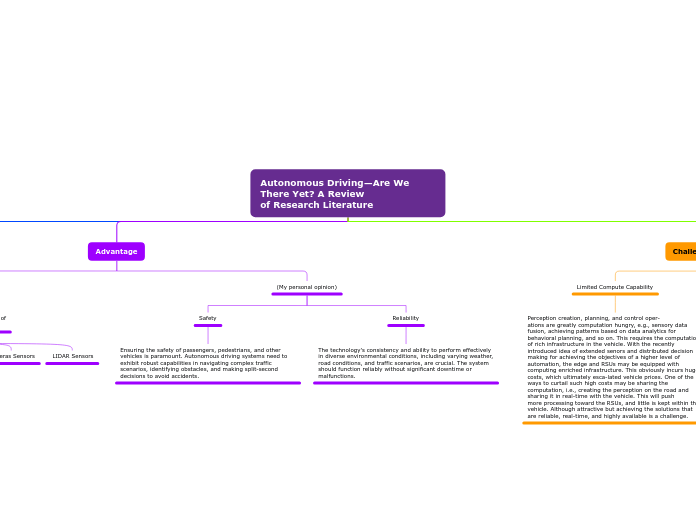Autonomous Driving—Are We There Yet? A Review
of Research Literature
INTRODUCTION
Autonomous vehicles are revolutionizing transport and next-generation autonomous mobility. Such vehicles are promising to increase road safety, improve traffic efficiency, reduce vehicle emission, and improve mobil-ity. However, for these vehicles to live up to their full potentials, there are significant research, technological and urgent organizational issues that need to be addressed to reach the highest level of automation, i.e., level 5. Sensors, communication, mobile edge computing, machine learning, data analytic, distributed learning,and so on, are examples of the building blocks technologies and concepts constituting the end-to-end solu-tion. This survey discusses these technologies and concepts and maps their roles to the end-to-end solution.It highlights the challenges for each technology. Moreover, this survey provides an analysis of different so-lution approaches proposed by relevant stakeholders, utilizing these technologies aiming to achieve level-5 autonomy.
Advantage
On-Board Information Sources
Autonomous vehicles are equipped with different types of
sensors and localization devices
Radar and Ultra-Sonic Sensor
Ground Penetrating and Road Condition Sensors
Cameras Sensors
LIDAR Sensors
(My personal opinion)
Safety
Ensuring the safety of passengers, pedestrians, and other vehicles is paramount. Autonomous driving systems need to exhibit robust capabilities in navigating complex traffic scenarios, identifying obstacles, and making split-second decisions to avoid accidents.
Reliability
The technology's consistency and ability to perform effectively in diverse environmental conditions, including varying weather, road conditions, and traffic scenarios, are crucial. The system should function reliably without significant downtime or malfunctions.
Challenge & Problem
Limited Compute Capability
Perception creation, planning, and control oper-
ations are greatly computation hungry, e.g., sensory data fusion, achieving patterns based on data analytics for behavioral planning, and so on. This requires the computation of rich infrastructure in the vehicle. With the recently introduced idea of extended senors and distributed decision making for achieving the objectives of a higher level of automation, the edge and RSUs may be equipped with computing enriched infrastructure. This obviously incurs huge costs, which ultimately esca-lated vehicle prices. One of the ways to curtail such high costs may be sharing the computation, i.e., creating the perception on the road and sharing it in real-time with the vehicle. This will push
more processing toward the RSUs, and little is kept within the vehicle. Although attractive but achieving the solutions that are reliable, real-time, and highly available is a challenge.
Limited Communication Capability
Mobile network technologies of the
recent past failed to meet the stringent requirements of latency, throughput, reliability, and avail-
ability. The information is captured through sensors, which require a high data rate for live video streaming, transfer of High Definition (HD) maps, and so on. With advances
in sensor technology, we may expect more immersive types of application, e.g., virtual reality
(VR) and augmented reality (AR). Hence, 5G mobile networks and other enabling concepts like
MEC will be the technology of choice when it comes to realizing the use cases of autonomous driv-
ing. It is worth reiterating here that implanting intelligence on the vehicle only does not address
the challenges of achieving a fully autonomous vehicle. The vehicles need to be connected with objects around it and distant information sources, hence termed as CVs. Connected and automated vehicles make decisions based on the distributed information pieces, which should be made avail-
able when and where needed. A vehicle will be connected to pedestrians, other vehicles, backends
of different stakeholders, road infrastructure, and so on via reliable communication bit-pipes. 5G
core components with MEC and on-road deployed infrastructure will interplay to evolve the au-
tonomous driving capabilities. However, the following technical challenges should be looked into
when realizing the goals of fully autonomous vehicles.
CONCLUSION
Achieving L-5 autonomous driving requires a real time, distributed, and privacy preserving intel-
ligence. In this article, we described the building blocks technologies to achieve design goals, such
as communication, computation, and artificial intelligence. Due to its importance in realizing L-5
autonomous driving, the article dove deep into V2X and perception enhancement, and associated
challenges. We exhaustively analyzed relevant research works for each.
